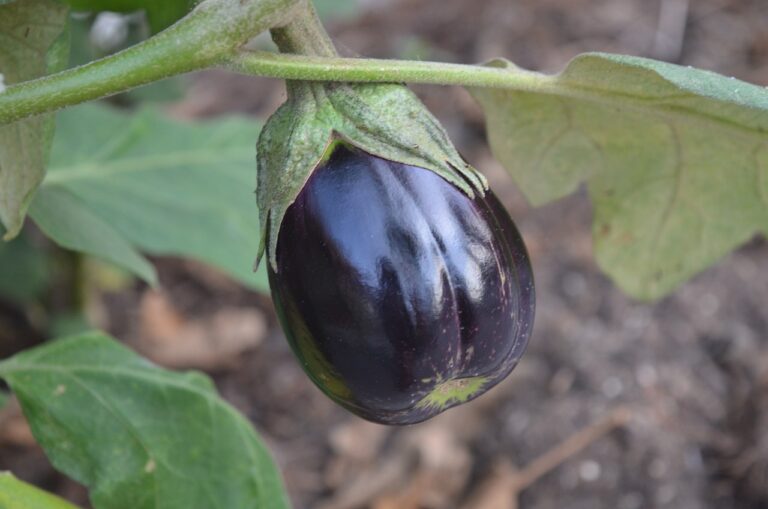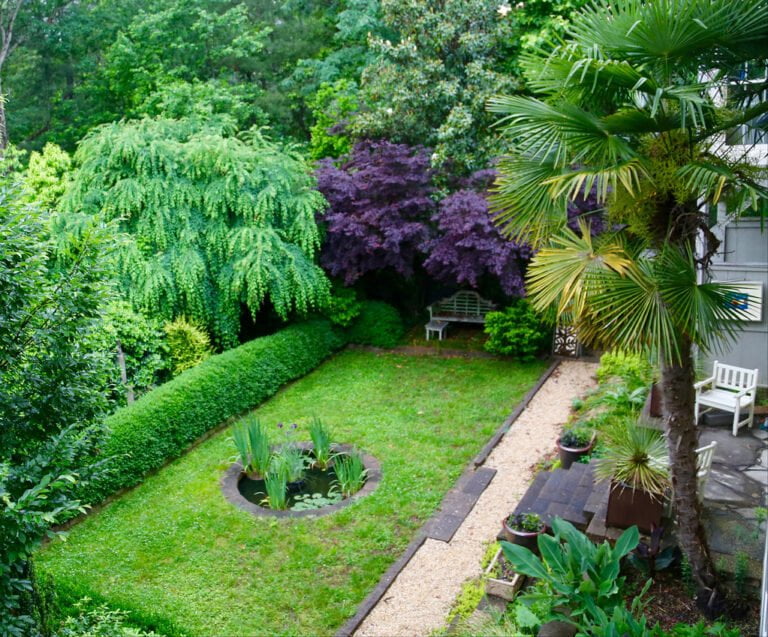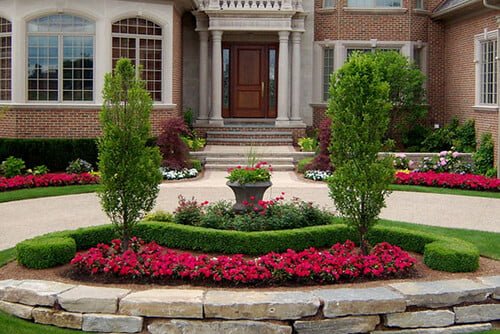Understanding and Choosing Color Schemes for Seasonal Landscaping
Are you ready to elevate your seasonal landscaping with vibrant color schemes? Discover the impact of seasonal changes on your outdoor space and learn how to create harmonious combinations that enhance curb appeal. With practical advice and nature-inspired expertise, you'll understand the importance of color psychology in landscaping and the benefits of incorporating native flora. Get ready to elevate your outdoor space and create a welcoming environment with professional consultation benefits.
Importance of Color Schemes
When planning your seasonal landscaping, you should consider the importance of color schemes to create visual interest and cohesion throughout the year. The right color scheme can enhance the beauty of your garden and evoke different moods. For instance, warm colors like red, orange, and yellow can create a vibrant and energetic atmosphere, perfect for the summer months. On the other hand, cool colors such as blue, purple, and green can impart a sense of calm and tranquility, ideal for the spring or fall. It's essential to choose a color scheme that transitions smoothly from one season to the next, ensuring a harmonious flow of colors. By understanding the significance of color schemes, you can create a visually appealing and balanced landscape that serves as a delightful retreat for both yourself and others.
Impact of Seasonal Changes
Considering the impact of seasonal changes is essential for maintaining a vibrant and cohesive color scheme in your landscaping. Each season brings about distinct shifts in temperature, light, and moisture levels, which directly influence the growth and appearance of plants. Understanding these changes allows you to plan your color scheme accordingly, ensuring that your landscaping remains visually appealing throughout the year. For instance, in spring, vibrant hues and pastel tones can breathe life into your garden, while the warm and fiery colors of fall can create a cozy and inviting atmosphere. By selecting plants that bloom or change color with the seasons, you can create a dynamic and ever-changing landscape that captivates the senses. Embracing the impact of seasonal changes not only enhances the beauty of your outdoor space but also fosters a deeper connection with nature.
Color Psychology in Landscaping
To further enhance your landscaping, consider the psychological impact of colors on human emotions and behaviors as you plan your seasonal color scheme. Color psychology plays a significant role in creating a harmonious and inviting outdoor space. Warm tones like reds, oranges, and yellows can evoke feelings of energy and warmth, making them ideal for spring and summer landscapes. On the other hand, cool tones such as blues, purples, and greens are calming and can be perfect for fall and winter settings. Understanding the impact of different colors on mood and perception can help you create a balanced and emotionally engaging environment. Remember to consider the overall atmosphere you want to create and the specific emotions you wish to evoke when selecting colors for your landscaping.
Creating Harmonious Combinations
As you consider creating harmonious combinations for your seasonal landscaping, it's important to build upon the psychological impact of colors on human emotions and behaviors. Start by using a color wheel to guide your choices. Harmonious combinations often involve analogous colors, such as pairing shades of red, orange, and yellow for a warm and inviting feel. You can also create harmony by combining complementary colors, like blue and orange, for a vibrant and dynamic look. Additionally, consider the foliage and flower colors of your existing plants to ensure your new additions integrate seamlessly. Remember, creating harmonious combinations is not just about the colors themselves, but also about how they interact with the surrounding environment and your personal preferences. Keep experimenting and fine-tuning until you achieve the perfect blend of colors that enhances your seasonal landscaping.
Utilizing Focal Points
You can create visual interest and draw attention to specific areas of your seasonal landscaping by utilizing focal points strategically. Consider using features such as a striking tree, a captivating sculpture, or a colorful flower bed to anchor and define different areas in your garden. Focal points help guide the eye and create a sense of balance and harmony in your outdoor space. When selecting focal points, think about the scale, color, and texture to ensure they complement the overall design of your landscaping. Position them where they can be easily viewed from various vantage points, enhancing the visual appeal of your garden. By incorporating focal points thoughtfully, you can elevate the beauty of your seasonal landscaping and create memorable outdoor experiences for yourself and others.
Adapting to Different Seasons
Consider incorporating a variety of plants and flowers that bloom during different seasons to ensure your landscaping remains vibrant throughout the year. For spring, include tulips, daffodils, and cherry blossoms to bring bursts of color. In summer, opt for vibrant blooms like roses, hydrangeas, and sunflowers. Fall can be highlighted with the warm hues of marigolds, asters, and chrysanthemums. Embrace the winter season with evergreen plants like holly, spruce, and winterberry. By strategically selecting plants that thrive in each season, you can maintain a visually appealing landscape year-round. Additionally, consider incorporating ornamental grasses and foliage with varying textures to add interest during dormant periods. Adapting to different seasons ensures that your outdoor space remains inviting and captivating, providing a welcoming environment for all who enjoy it.
Incorporating Native Flora
Incorporating native flora enhances the sustainability and resilience of your seasonal landscaping, ensuring that your outdoor space remains vibrant and thriving year-round. Native plants are well-adapted to the local climate, soil, and wildlife, making them low-maintenance and beneficial for the ecosystem. When selecting native flora, consider the specific growing conditions of your area, such as sunlight, water availability, and soil type. Choose a variety of plants that bloom and provide interest throughout the seasons, ensuring continuous beauty in your landscape. Additionally, native flora attracts native pollinators and wildlife, contributing to a healthy and balanced ecosystem. By incorporating native flora into your landscaping, you not only create a visually appealing outdoor space but also contribute to the preservation of the local environment.
Long-term Maintenance Considerations
To ensure the longevity and vitality of your seasonal landscaping, it is essential to establish a comprehensive long-term maintenance plan that addresses the specific needs of the native flora and accounts for seasonal changes in environmental conditions. Regular monitoring and care are crucial to sustain the health and beauty of your landscape. Implement a watering schedule tailored to the needs of each plant species, considering factors such as soil type and drainage. Prune and mulch as needed to promote growth and protect against harsh weather. Regularly inspect for pests and diseases, addressing any issues promptly to prevent spread. Furthermore, consider the long-term impact of fertilizers and opt for organic options to maintain soil health. By proactively tending to the unique requirements of your plants, you can ensure a flourishing and sustainable seasonal landscape for years to come.
Enhancing Curb Appeal
To enhance the curb appeal of your seasonal landscaping, prioritize selecting color schemes that complement your property's architecture and surroundings. Consider the existing colors of your home, such as the roof, siding, and trim, and choose plantings that harmonize with these hues. For example, if your home has warm earthy tones, opt for a color scheme with rich reds, oranges, and yellows to create a cohesive look. Additionally, take into account the surrounding landscape, including neighboring properties and natural elements. Selecting colors that echo the tones of the environment can help your landscaping blend seamlessly into the setting. By thoughtfully integrating your seasonal color schemes with the existing features of your property, you can elevate its visual appeal and create a welcoming atmosphere for both residents and visitors.
Professional Consultation Benefits
Consider seeking professional consultation to gain valuable insights into optimizing your seasonal landscaping color schemes. A horticultural expert can provide tailored advice based on your specific location, climate, and soil conditions. They can help you choose the right plants and colors that thrive in each season, ensuring a vibrant and cohesive landscape year-round. Professional consultation offers practical guidance on plant selection, placement, and maintenance, taking into account factors such as sunlight exposure and water requirements. By enlisting the expertise of a professional, you can avoid costly mistakes and maximize the visual impact of your outdoor space. Their nature-inspired knowledge will help you create a harmonious and inviting environment that enhances the beauty of your property. Serving others through professional consultation ensures that your seasonal landscaping color schemes are not only visually appealing but also sustainable and thriving.
Conclusion
In conclusion, choosing the right color scheme for your seasonal landscaping is essential for creating a harmonious and visually appealing outdoor space. By understanding the impact of seasonal changes, utilizing color psychology, and incorporating native flora, you can enhance your curb appeal and create a beautiful outdoor environment. Consider seeking professional consultation to ensure long-term maintenance and to make the most of your landscaping efforts. Happy planting!





